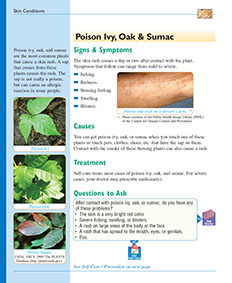CONDITIONS
SYMPTOM CHECKER
Male
Female
Child
Arm, Hand & Shoulder Concerns
Legs & Feet Concerns
Dental & Mouth Concerns
Ear & Nose
Eye Conditions
Head Conditions
Arm, Hand & Shoulder Concerns
Legs & Feet Concerns
Front
Back
Arm, Hand & Shoulder Concerns
Dental & Mouth Concerns
Ear & Nose
Eye Conditions
Head Conditions
Arm, Hand & Shoulder Concerns
Dental & Mouth Concerns
Ear & Nose
Eye Conditions
Head Conditions
Front
Back
Arm, Hand & Shoulder Concerns
Neck Links
Head & Neck Concerns
Arm, Hand & Shoulder Concerns
Neck Links
Head & Neck Concerns
Front
Back
Online Clinic
Wise Healthcare
Poison Ivy, Oak & Sumac
Print on Demand
RELATED ARTICLES
Poison ivy, oak, and sumac are the most common plants that cause a skin rash. A sap that comes from these plants causes the rash. The sap is not really a poison, but can cause an allergic reaction in some people.



Signs & Symptoms
The skin rash comes a day or two after contact with the plant. Symptoms that follow can range from mild to severe.
Causes
You can get poison ivy, oak, or sumac when you touch one of these plants or touch pets, clothes, shoes, etc. that have the sap on them. Contact with the smoke of these burning plants can also cause a rash.
Treatment
Self-care treats most cases of poison ivy, oak, and sumac. For severe cases, your doctor may prescribe medicine(s).
Questions to Ask
Question 1
After contact with poison ivy, oak, or sumac, do you have any of these problems?
• The skin is a very bright red color.
• Severe itching, swelling, or blisters.
• A rash on large areas of the body or the face.
• A rash that has spread to the mouth, eyes, or genitals.
• Pus.
You should be seen by your doctor for medical advice. Contact your doctor or health care provider to find out how soon you should be seen.
Use Self-Care / Prevention:
You can probably take care of the problem yourself if you answered NO to all the questions. Use the “Self-Care” measures that are listed. Call your doctor if you don’t feel better soon, though. You may have some other problem.
Self-Care / Prevention
To Prevent Getting a Rash
• Know what these plants look like and avoid them.
– Poison ivy and poison oak both have 3 leaflets per stem. This is why you may have heard the saying, “Leaflets three, let them be.”
– Each branch of poison sumac has 7 to 13 leaflets on a reddish stem. A single leaf is on the end of the stem. The others are paired along each side of the stem. Poison sumac grows in wetlands.
• Use an over-the-counter lotion (IvyBlock), which blocks skin contact with the sap. Use it as directed.
• Wear pants and long-sleeved shirts.
• Use an over-the-counter product (e.g., Tecnu) that removes poison ivy sap.
• Rinse the affected area with water.
• To help prevent an allergic reaction, do the things listed below. Do them within 6 hours of contact with one of the plants.
– Remove all clothes and shoes that have touched the plant.
– Wash the skin area well with soap and water.
– Use an over-the-counter product (e.g., Tecnu) that removes poison ivy sap.
To Treat Poison Ivy, Oak, or Sumac
• Take a cold shower, put the rash area in cold water, or pour cold water over it. Use soap when you shower.
• To relieve itching, take an over-the-counter antihistamine, such as Benadryl. Follow the label’s directions.
• For weeping blisters, mix 2 teaspoons of baking soda in 4 cups of water. Dip squares of gauze in this mixture. Cover the blisters with wet gauze for 10 minutes, 4 times a day. Do not apply this to the eyes.
• Wash all clothes and shoes with hot water and a strong soap. Bathe pets that have come in contact with the plant. The sap can stay on pets for many days. Clean items used to wash clothing and pets. Wear rubber gloves when you do all these things.
• Keep your hands away from your eyes, mouth, and face.
• Do not scratch or rub the rash.
• Take baths with lukewarm water. Add an over- the-counter product called Aveeno colloidal oatmeal.
• Apply any of these to the skin rash:
– Calamine (not Caladryl) lotion.
– Over-the-counter hydrocortisone cream. Follow the directions on the label.
– A paste of 3 teaspoons of baking soda and 1 teaspoon of water.
This website is not meant to substitute for expert medical advice or treatment. Follow your doctor’s or health care provider’s advice if it differs from what is given in this guide.
The American Institute for Preventive Medicine (AIPM) is not responsible for the availability or content of external sites, nor does AIPM endorse them. Also, it is the responsibility of the user to examine the copyright and licensing restrictions of external pages and to secure all necessary permission.
The content on this website is proprietary. You may not modify, copy, reproduce, republish, upload, post, transmit, or distribute, in any manner, the material on the website without the written permission of AIPM.
2021 © American Institute for Preventive Medicine - All Rights Reserved. Disclaimer | www.HealthyLife.com
















































